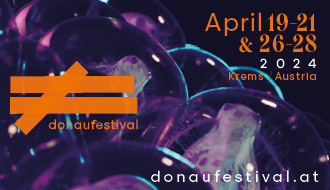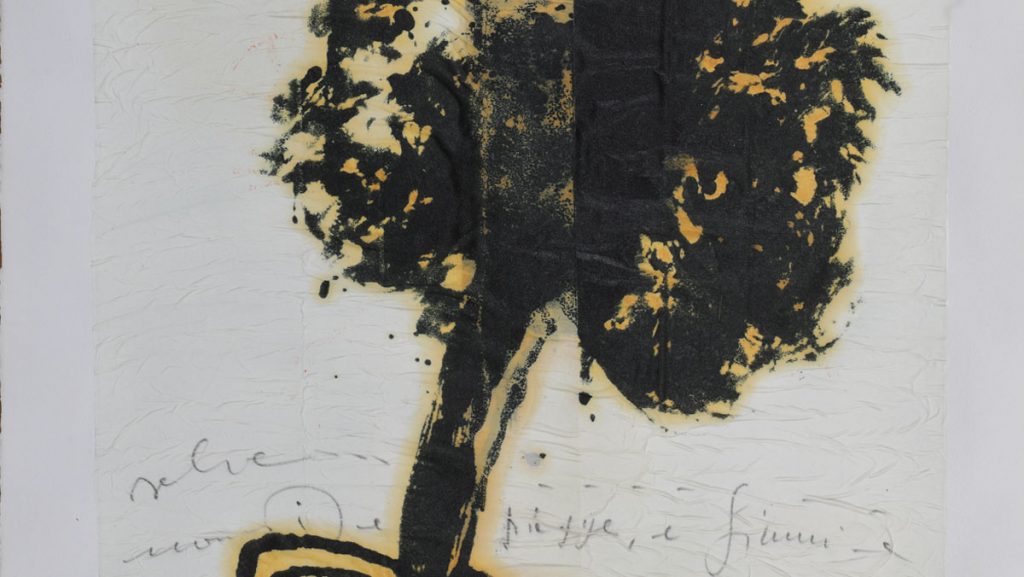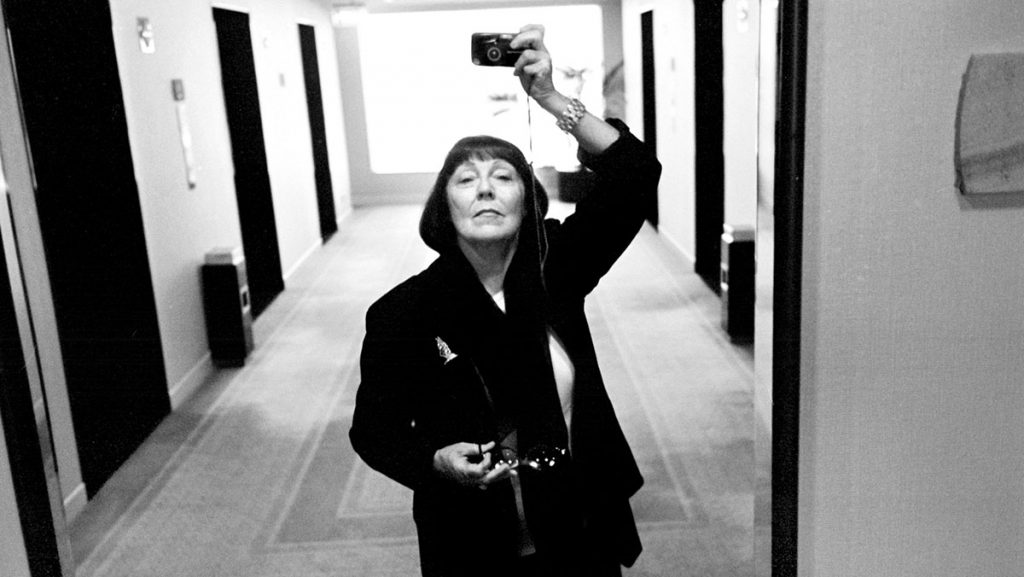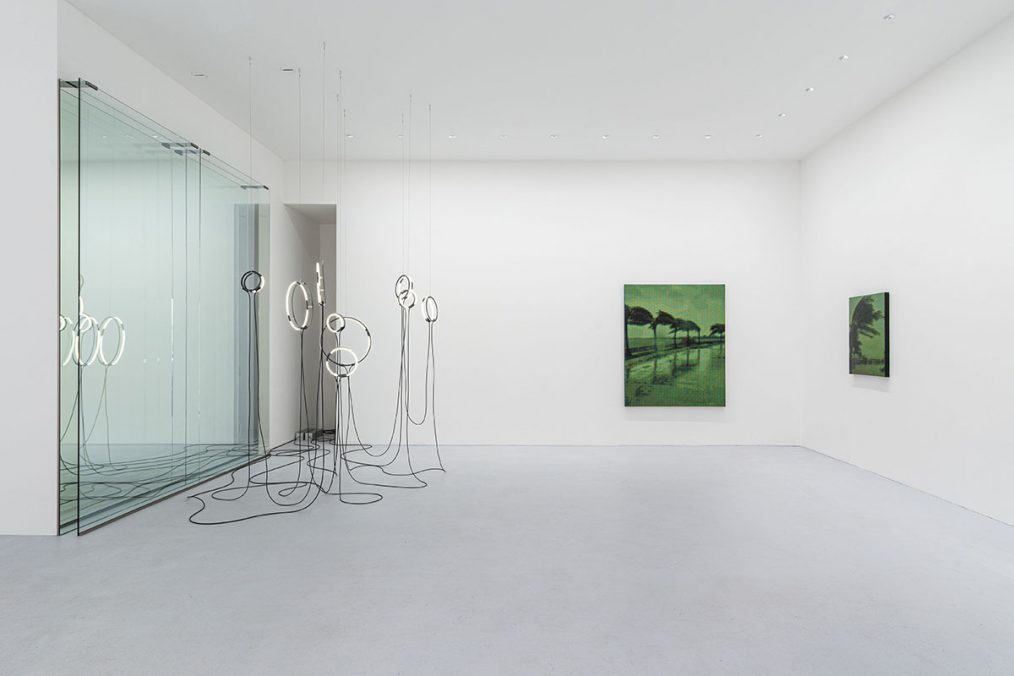
Both artistic positions question different forms of representation via a subversive examination of abstraction and new pictorial formulas. Their works operate in a long tradition in the fine arts of utilizing scientific methods, but they are about more than powerful aesthetic and conceptual visual phenomena; rather, through language, codes, and algorithms they pursue a critical examination of contemporary issues, from climate policy to digitization.
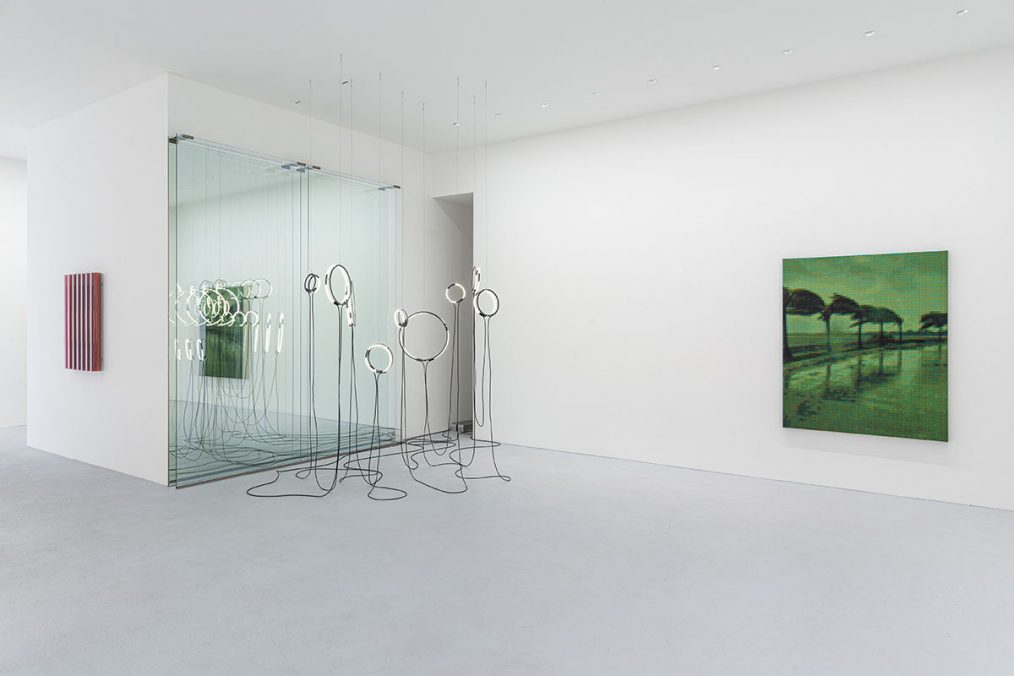
Installation view | poetics of reality (encoded) | brigitte kowanz and troika | Photo: Dirk Tacke 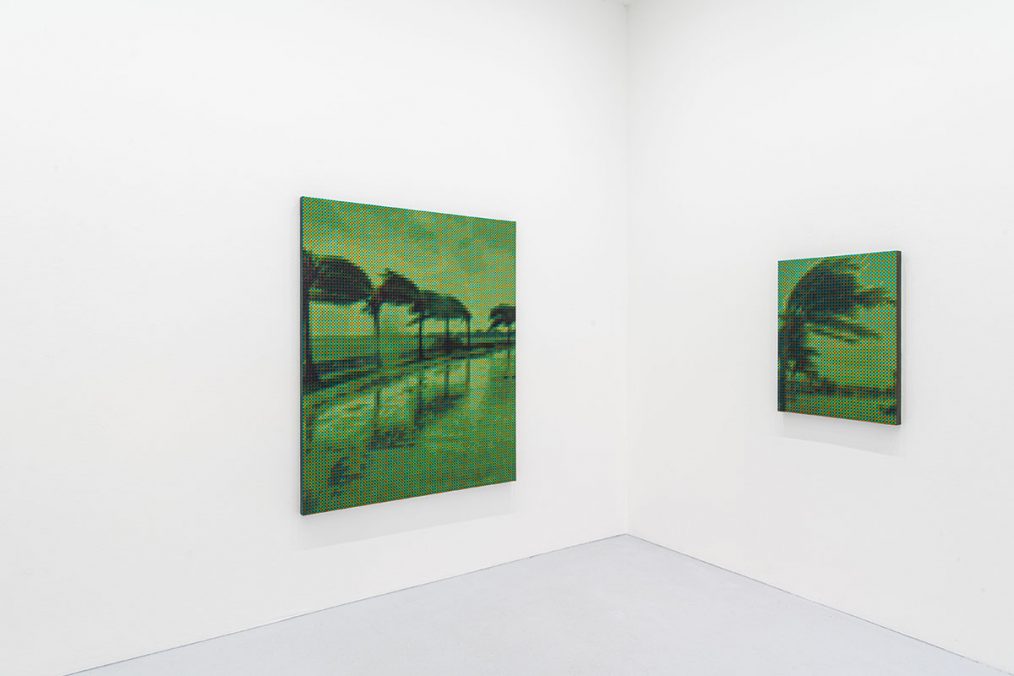
Installation view | poetics of reality (encoded) | brigitte kowanz and troika | Photo: Dirk Tacke
Light is Kowanz’s primary artistic medium. It can be experienced as an independent phenomenon, as a material, and as a carrier of information in which language, for instance political or historical statements, is combined with formal aesthetics. In her light sculptures, like the new Networks series (2020), which involves neon tubes conveying Morse code messages, the Austrian artist visualizes the complex relationship between seeing, reading, understanding, perceiving, and recognizing. The shapes and segmentations of the neon tubes translate verbal syntax into binary code, which serves as a formal element and carrier of a second level of meaning.
World Wide Web 12.03.1989 06.08.1991 (2017) is a Morse code version of the two historical dates on which the internet was presented and then made accessible to the world, and takes the shape of a luminous, curved cable – another kind of transmitter of information – within a mirrored glass showcase.
Troika’s cross-media works investigate how new technologies permeate physical reality and individual perception. They translate human-made data and programmed digital systems, artificial intelligence, and algorithms with an underlying digital design language back into the physical world, thus revealing how technological progress and human relationships to perceptible reality influence one another. Hierophany (2019) consists of thousands of black and white dice, which assembled together, line by line, form an image by manually imitating a mathematical model, the cellular automata. This originally abstract simulation generates complex patterns on the basis of relatively simple algorithms. According to this, Troika makes the spatial arrangement of the colors, values, and positioning of the physical dice, thus transferring into analog reality.
The encounter between real and virtual space in the works of both Kowanz and Troika becomes particularly clear in their references to coded language. Kowanz’s installation Relations (2021) is composed of nine white neon light rings, each depicting a letter in Morse code. Cables fall from the rings like a three-dimensional drawing, a metaphor for connection and networking. By mirroring the ostensibly hovering circles of light, they are multiplied to infinity; the spatial oscillation of the light, spreading out in all directions, is further intensified. In the installation’s expansion, the virtual connects with actual space, at the same time provoking viewers’ participation via their mirrored images. Two Troika series, Borrowed Light (2018–21) and Unstable Constructs (2021), also illustrate the interchangeability of spatial experience and one’s view of reality. In the first, pieces of photographic film, previously exposed with a colored laser, are fixed onto an acrylic plate, resulting in a flow of intense color fields. The work evokes an endless loop of sunset and sunrise.
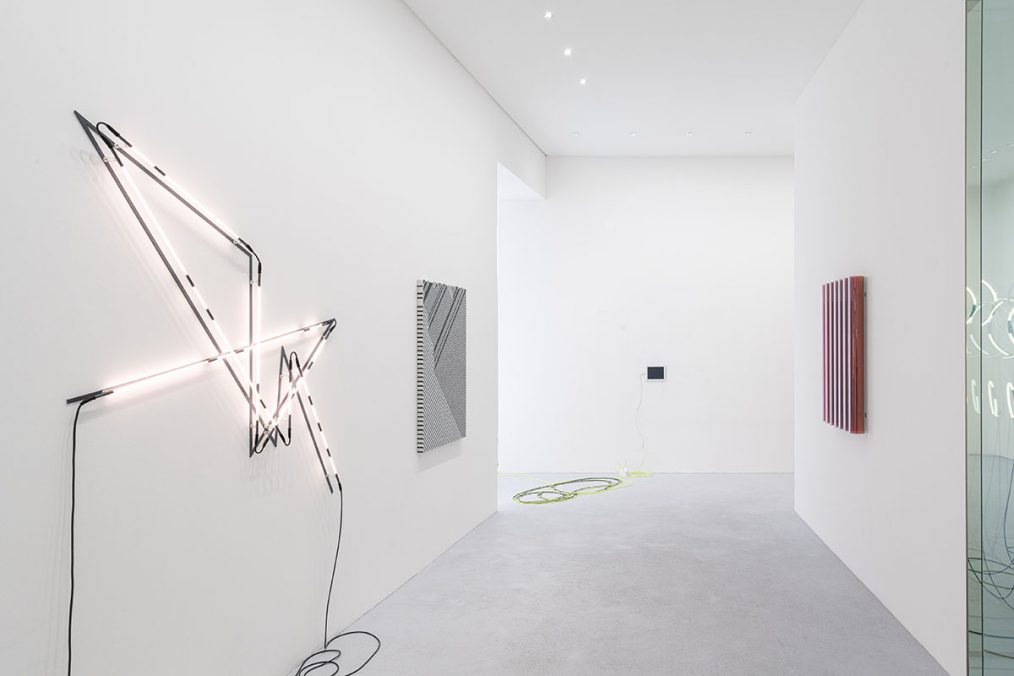
Installation view | poetics of reality (encoded) | brigitte kowanz and troika | Photo: Dirk Tacke 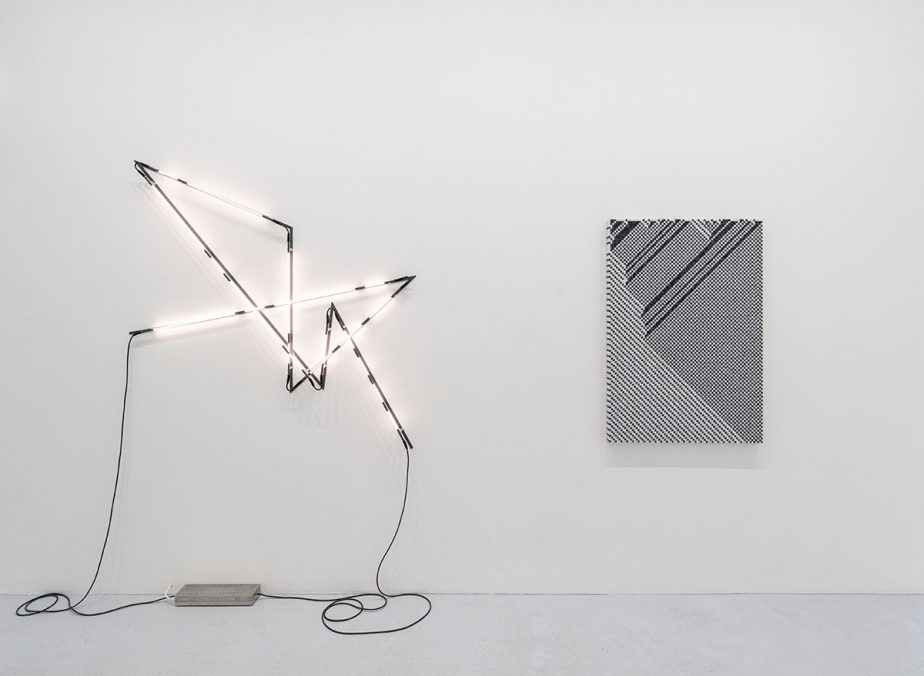
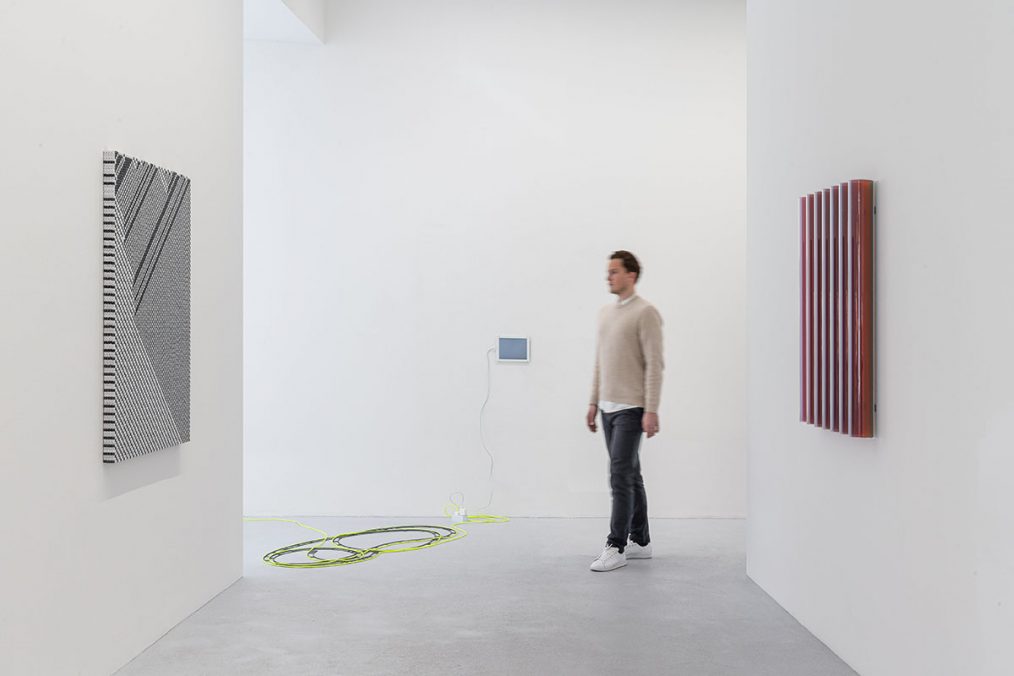
Installation view | poetics of reality (encoded) | brigitte kowanz and troika | Photo: Dirk Tacke
In addition to dealing with perception, representation of reality, and formal reduction, the works of both positions are characterized by an immanent second level of meaning, in which critical attitudes toward processes of digitization and associated social developments are revealed. Troika’s series Irma watched over by machines (2019–2020) shows images recorded in 2017 by surveillance cameras during Hurricane Irma, whose winds hit record-high levels. The artists transferred the digital recordings from their original RGB color spectrum into a painterly composition. In order to reproduce the color of the enlarged pixels from sixteen red, green, and blue tones, the artists imitate an algorithm in raster graphics, which calculated or interpolated the exact color information using neighboring brightness values. The works juxtapose the devastating effects of the natural disaster with the merciless logic of artificial intelligence, all executed with neutral eyes. The role of algorithms in their artistic process can be understood as an expression of rapid technological and associated social change, on which Troika reflects in their works.
Kowanz’s UN Climate Change Conference Paris 30.11.2015 12.12.2015 (2019) refers to the dates of the Paris Convention, which since its adoption obliges all member states to limit human-induced global warming. In Morse code, the artist has inscribed these significant dates of the negotiations within spiral-shaped neon tubes as both a testimony to contemporary European history and a reminder of the global responsibility of each individual. As part of her presentation in the Austrian Pavilion at the 57th Venice Biennale in 2017, Kowanz showed a series of works explicitly dedicated to the topic of digitization. In Email 02.08.1984 03.08.1984 (2020), the Morse code is transformed: the dates the first email was sent appear on an iPad as a light and acoustic signal. Kowanz’s new series Acronyms (2020) illustrates not only that the invention of email accelerated everyday communication in previously unimaginable ways, but also how this digital progress is fundamentally changing language. In the artist’s handwriting, common abbreviations of English-language idioms in virtual correspondence, such as tbh (to be honest) or afaik (as far as I know), are presented as neon letters. The title of the exhibition refers to the coded forms of language used by the artists, and at the same time points beyond the strong visual presence of the individual works to their underlying poetics, which operate beyond describable reality.
Curated by Madeleine Freund, the exhibition was conceived in collaboration with the Mexico City gallery OMR.
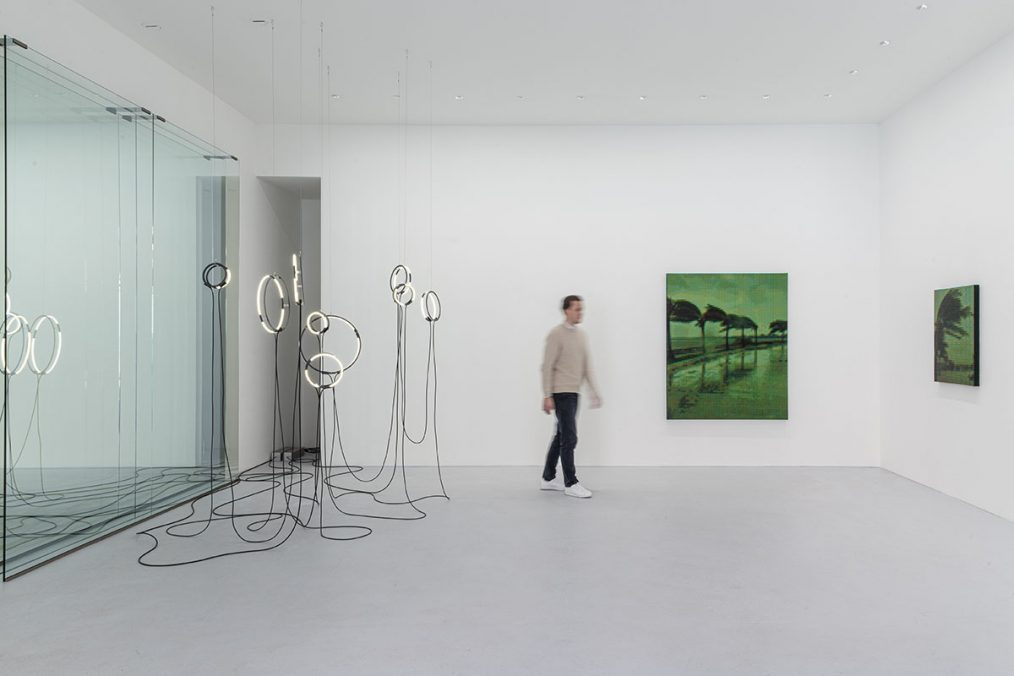
About the artists.
Brigitte Kowanz. The Austrian artist Brigitte Kowanz (*1957, Vienna) makes light her primary artistic medium. She continuously examines its different qualities and manifestations via objects, installations, and spatial interventions using various illuminants. The medium of light is made tangible and treated as an independent phenomenon, material, and information carrier, as well as a metaphor for a search for new forms of representation of visible reality. Kowanz combines language—for instance political statements and news transmissions—with formal aesthetics, illustrating that light is not just a neutral vehicle for information, but plays a decisive role in shaping it. Kowanz was awarded the Großer Österreichischder Staatspreis (Grand Austrian State Prize) in 2009 and exhibited at the Austrian Pavilion at the 57th Venice Biennale (2017). She has held a professorship at the University of Applied Arts in Vienna since 1997. Selected solo exhibitions have taken place in the Museum Haus Konstruktiv, Zurich (2020), Taxispalais, Innsbruck (2011), and the Museum of Modern Art Foundation Ludwig, Vienna (2010).
Troika. Troika is a collaborative contemporary art group founded in 2003 by Eva Rucki (1976, Germany), Conny Freyer (1976, Germany), and Sebastien Noel (*1977, France). The artists live and work in London. With a particular interest in subjective and objective readings of reality and various relationships involving humans and technology, Troika examines how information is transmitted in the digital world and how it transitions into physical reality. Their works deal with different systems of representation and illustrate how technological progress and human reality influence each other. Selected solo exhibitions have been presented at Barbican Gallery, London (2019), NC Arte, Bogotá (2015), and the Daelim Museum, Seoul (2014). Troika’s cross-media works are part of the collections of the Center Pompidou, Paris; M+, Hong Kong; the Victoria & Albert Museum, London; the Art Institute of Chicago; the Museum of Modern Art, New York; Jumex Collection, Mexico City; and the Eretz Israel Museum, Tel Aviv. Troika realized three site-specific installations for the British Pavilion at World Exhibition 2010 Shanghai.
Exhibition: poetics of reality (encoded) Brigitte Kowanz and Troika
Duration: 6 April – 2 June 2021
Adress and contact:
max goelitz
Maximilianstrasse 35, entrance Herzog-Rudolf-Straße
80539 Munich
www.maxgoelitz.com


